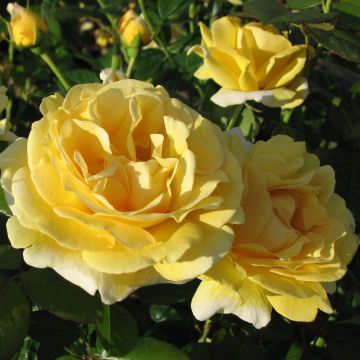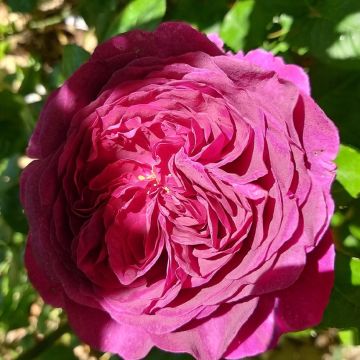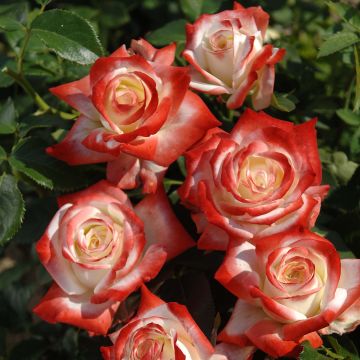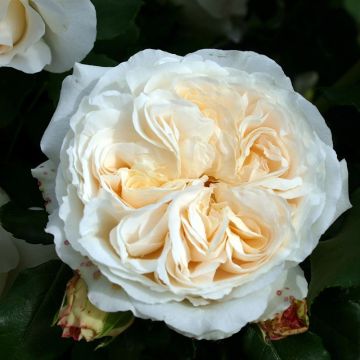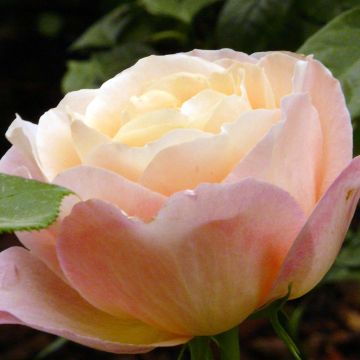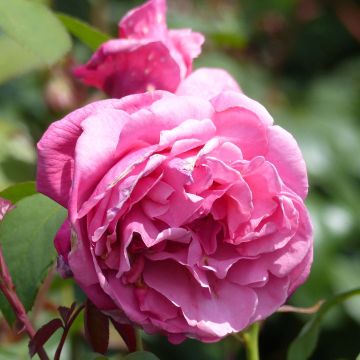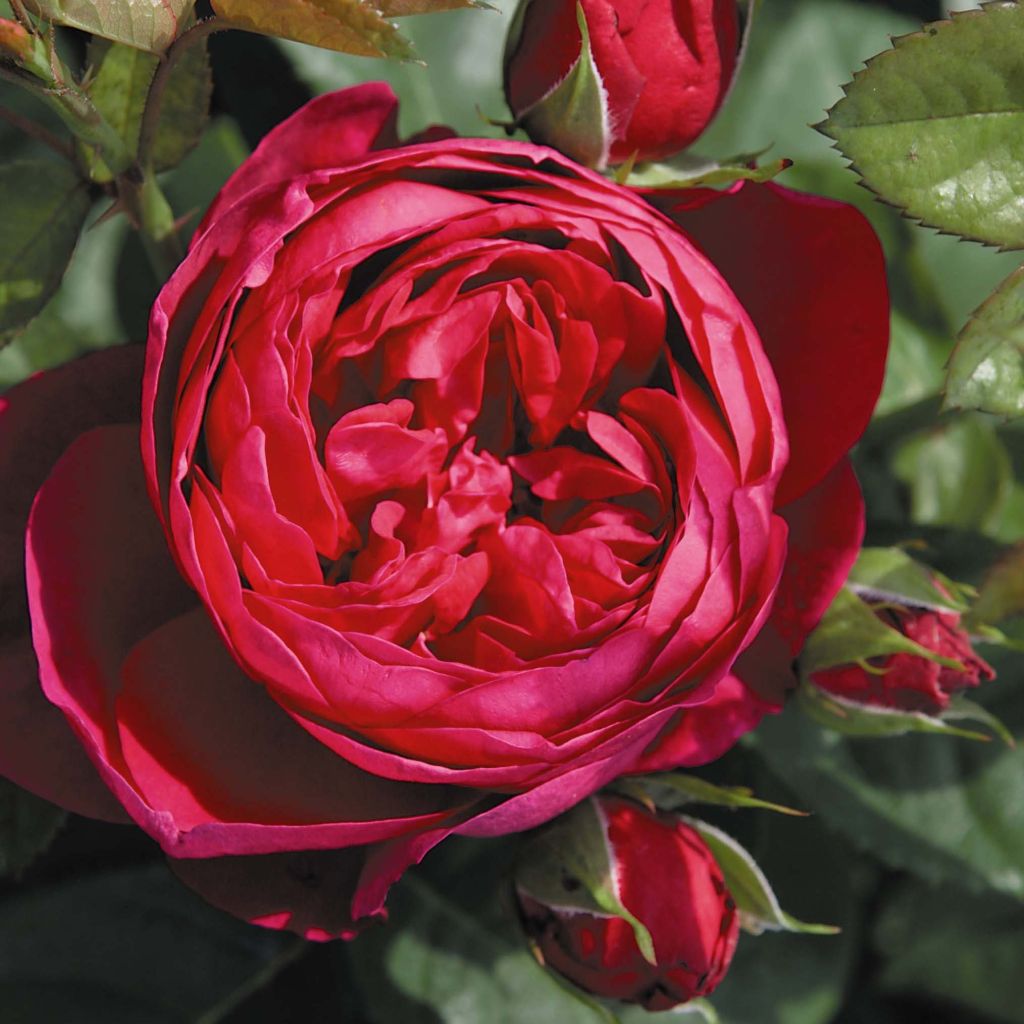

Rosa 'Trocadéro'
Rosa 'Trocadéro'
Rosa Trocadéro
Modern hybrid floribunda rose.
This item cannot be shipped to the selected country
Delivery charge from €5.90
Delivery charge from €5.90
Delivery to Corse prohibited
More information
Schedule delivery date,
and select date in basket
This plant carries a 24 months recovery warranty
More information
We guarantee the quality of our plants for a full growing cycle, and will replace at our expense any plant that fails to recover under normal climatic and planting conditions.
From €5.90 for pickup delivery and €6.90 for home delivery
Express home delivery from €8.90.
From €5.90 for pickup delivery and €6.90 for home delivery
Express home delivery from €8.90.
Delivery to Corse prohibited: UE law prohibits the import of this plant from mainland France to Corse as part of the fight against Xylella fastidiosa. Please accept our sincere apologies.
More information
Does this plant fit my garden?
Set up your Plantfit profile →
Description
The 'Trocadéro' Rose (Tan 10721) is a modern hybrid from the 'Les Années Folles' series, bringing together the chic of cherry red and a sweet fragrance on its large romantic roses. In addition to its ornamental qualities, it is a robust bush that is resistant to rose diseases. Its opulent, old-fashioned flowers, full of fragrant petals, make for magnificent bouquets. You can place this rose at the turn of a path or near the terrace to enjoy it with every passing.
The 'Trocadéro' Rose is a recent creation by the German rose breeder Tantau. This hybrid rose is classified as a Floribunda, with flowers grouped in corymbs or small bouquets.
The plant forms an upright, ramified bush with vigorous and rapid growth. It will reach approximately 85cm (34in) in height and 70cm (28in) in width. It blooms from May-June until late in the season. The young shoots of this rose are purple and unfold into compound leaves with large, toothed leaflets of a shiny dark green, being less susceptible to diseases. The flowers measure 10 to 12cm (4 to 5in) in diameter and are composed of 140 petals. They have a globular shape and open in the manner of old roses, with tightly packed quarters. The colour of the roses is a deep cherry red, very bright. They have a pronounced fragrance. This deciduous, hardy shrub loses its leaves in autumn. It will thrive when planted in a rich, deep soil that remains cool in summer.
This modern 'Trocadero' rose is a variety of great class, as beautiful as it is rewarding. Place it, for example, at the front of a shrub bed, in groups of 3 to 5, in a low hedge, or as a standalone in a well-maintained small garden. It can also be grown in a large pot, with regular watering and fertilizing. Consider pairing it with small white, blue, or pink flowers that will enhance it without overshadowing it. Perennial geraniums, catmints, Campanulas (lactiflora, rapunculoides), perennial salvias, and foxgloves are good companions for roses. Its long-lasting flowers are perfect for creating bold, fragrant bouquets that will scent the house.
Report an error about the product description
Rosa 'Trocadéro' in pictures


Plant habit
Flowering
Foliage
Botanical data
Rosa
Trocadéro
Rosaceae
Modern hybrid floribunda rose.
Cultivar or hybrid
Rosa multiflora (4L/5L pot)
Other Large-flower tea Roses
Planting and care
To plant your 'Trocadéro' rose, work the soil to a depth of 25cm (10in), crumbling the soil well and adding a base amendment such as dried blood or dehydrated horn at the bottom of the planting hole. Position your plant, removing it from its pot, and cover the top of the root ball with 3cm (1in) of soil. Fill in the hole and water thoroughly to eliminate any air pockets. In dry weather, it is necessary to water regularly for a few weeks to facilitate root growth. Also, remember to provide your rose with special rose fertilizer to stimulate flowering. Choose a sunny location or partial shade in very hot regions.
Planting period
Intended location
Care
-
, onOrder confirmed
Reply from on Promesse de fleurs
Haven't found what you were looking for?
Hardiness is the lowest winter temperature a plant can endure without suffering serious damage or even dying. However, hardiness is affected by location (a sheltered area, such as a patio), protection (winter cover) and soil type (hardiness is improved by well-drained soil).

Photo Sharing Terms & Conditions
In order to encourage gardeners to interact and share their experiences, Promesse de fleurs offers various media enabling content to be uploaded onto its Site - in particular via the ‘Photo sharing’ module.
The User agrees to refrain from:
- Posting any content that is illegal, prejudicial, insulting, racist, inciteful to hatred, revisionist, contrary to public decency, that infringes on privacy or on the privacy rights of third parties, in particular the publicity rights of persons and goods, intellectual property rights, or the right to privacy.
- Submitting content on behalf of a third party;
- Impersonate the identity of a third party and/or publish any personal information about a third party;
In general, the User undertakes to refrain from any unethical behaviour.
All Content (in particular text, comments, files, images, photos, videos, creative works, etc.), which may be subject to property or intellectual property rights, image or other private rights, shall remain the property of the User, subject to the limited rights granted by the terms of the licence granted by Promesse de fleurs as stated below. Users are at liberty to publish or not to publish such Content on the Site, notably via the ‘Photo Sharing’ facility, and accept that this Content shall be made public and freely accessible, notably on the Internet.
Users further acknowledge, undertake to have ,and guarantee that they hold all necessary rights and permissions to publish such material on the Site, in particular with regard to the legislation in force pertaining to any privacy, property, intellectual property, image, or contractual rights, or rights of any other nature. By publishing such Content on the Site, Users acknowledge accepting full liability as publishers of the Content within the meaning of the law, and grant Promesse de fleurs, free of charge, an inclusive, worldwide licence for the said Content for the entire duration of its publication, including all reproduction, representation, up/downloading, displaying, performing, transmission, and storage rights.
Users also grant permission for their name to be linked to the Content and accept that this link may not always be made available.
By engaging in posting material, Users consent to their Content becoming automatically accessible on the Internet, in particular on other sites and/or blogs and/or web pages of the Promesse de fleurs site, including in particular social pages and the Promesse de fleurs catalogue.
Users may secure the removal of entrusted content free of charge by issuing a simple request via our contact form.
The flowering period indicated on our website applies to countries and regions located in USDA zone 8 (France, the United Kingdom, Ireland, the Netherlands, etc.)
It will vary according to where you live:
- In zones 9 to 10 (Italy, Spain, Greece, etc.), flowering will occur about 2 to 4 weeks earlier.
- In zones 6 to 7 (Germany, Poland, Slovenia, and lower mountainous regions), flowering will be delayed by 2 to 3 weeks.
- In zone 5 (Central Europe, Scandinavia), blooming will be delayed by 3 to 5 weeks.
In temperate climates, pruning of spring-flowering shrubs (forsythia, spireas, etc.) should be done just after flowering.
Pruning of summer-flowering shrubs (Indian Lilac, Perovskia, etc.) can be done in winter or spring.
In cold regions as well as with frost-sensitive plants, avoid pruning too early when severe frosts may still occur.
The planting period indicated on our website applies to countries and regions located in USDA zone 8 (France, United Kingdom, Ireland, Netherlands).
It will vary according to where you live:
- In Mediterranean zones (Marseille, Madrid, Milan, etc.), autumn and winter are the best planting periods.
- In continental zones (Strasbourg, Munich, Vienna, etc.), delay planting by 2 to 3 weeks in spring and bring it forward by 2 to 4 weeks in autumn.
- In mountainous regions (the Alps, Pyrenees, Carpathians, etc.), it is best to plant in late spring (May-June) or late summer (August-September).
The harvesting period indicated on our website applies to countries and regions in USDA zone 8 (France, England, Ireland, the Netherlands).
In colder areas (Scandinavia, Poland, Austria...) fruit and vegetable harvests are likely to be delayed by 3-4 weeks.
In warmer areas (Italy, Spain, Greece, etc.), harvesting will probably take place earlier, depending on weather conditions.
The sowing periods indicated on our website apply to countries and regions within USDA Zone 8 (France, UK, Ireland, Netherlands).
In colder areas (Scandinavia, Poland, Austria...), delay any outdoor sowing by 3-4 weeks, or sow under glass.
In warmer climes (Italy, Spain, Greece, etc.), bring outdoor sowing forward by a few weeks.

































